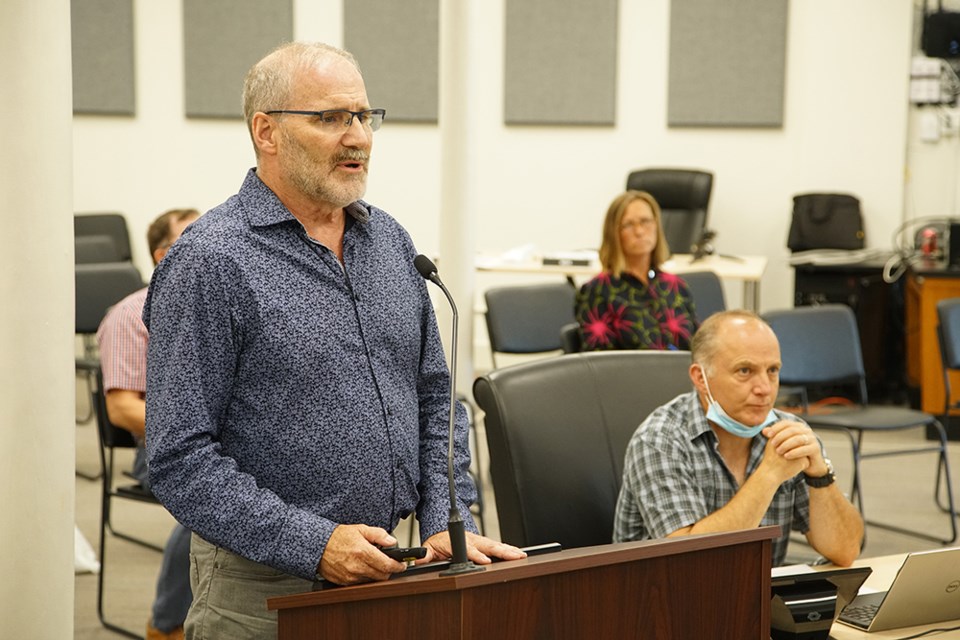If all goes according to plan, City of Powell River’s consolidated wastewater treatment plant will be processing liquid waste by the fall of 2022 and be completed by the spring of 2023.
At a special meeting on July 8, city councillors were briefed about the project by representatives of Associated Engineering (AE), the company that did the detailed design of the plant and is managing construction as well as progress of the contractors.
Tom Robinson, AE project manager, said during construction, engineers and other professionals who are part of the design process will be visiting the site at key intervals to inspect and confirm construction is in accordance with drawings and specifications. The environmental review team will also be making visits to ensure environmental protection and mitigation measures are properly implemented.
Robinson said the services are set to align with the city’s approved budget and affordability objectives.
In terms of schedule, Robinson said the main treatment plant contract award was completed on April 16, with Graham Infrastructure LP being awarded the contract. He said start-up of the liquid systems is planned for August 2022 and the solids systems start-up will be a little bit later. He said the outfall has to be constructed to start the facility, so it needs to have the same end date.
For linear work and pump stations, to deliver wastewater to the plant, the project is currently out to tender.
“By September 2022, we should be treating all of the city’s wastewater,” said Robinson.
In terms of cost control during construction, Robinson said it’s important for council to understand that construction costs can grow. He said a number of categories can cause this, such as owner-initiated changes or modifications to the design. Site conditions and unforeseen conditions can occur and design issues can also occur, according to Robinson.
“That’s why you have a construction contingency,” said Robinson. “Every project of this size will have some areas of added costs. It’s expected and it’s normal, and these are managed from the construction contingency.”
In terms of current activity, Robinson said Graham has four excavators on site and a number of trucks.
“There’s a lot of earth being moved at the moment,” added Robinson.
Outfall contract update
Regarding the outfall contract, Robinson said the original contract was terminated on March 31 and a closure process is being worked through with the company originally hired to do the work. Construction on the outfall came to a halt when Fisheries and Oceans Canada had concerns over environmental factors, which need to be mitigated before construction resumes.
“The city has engaged an environmental consultant who has developed a new concept for the pipeline through the tidal and subtidal zones,” said Robinson. “There will be a new permitting process. The outfall will be re-tendered and once awarded it will become a subcontract of Graham. Completion of the outfall is required for the plant to be commissioned.”
The next contract to be awarded is for conveyance and lift stations, which will involve piping of liquid waste to the plant, according to Robinson. The tender closes on July 15 and three BC companies were shortlisted to do the work.
In terms of processing wastewater, Robinson said it goes through a screening and de-gritting process of the raw wastewater when it comes in, followed by secondary treatment. He said sludge grown in the process is settled in a secondary clarifier, which is then disinfected with ultraviolet light and disposed safely back into the ocean through the outfall. Solids are dewatered and the plan is to continue to send the solids to the reuse site in Comox Valley.
Regarding odour control, Robinson said foul air from raw wastewater and odourous processes is going to be contained and treated with industry-leading odour technology. He said one of the benefits of this plant is that odour control is integrated into the design; it’s not an add-on after construction.
Robinson said the process in the Powell River plant is very good and is at the front end of where the industry is. The design had a third-party technical review by a US-based wastewater consultant and this system received a thumbs-up, according to Robinson.
He said a common question is regarding why aeration tanks are not covered. He said tanks are commonly not closed in treatment plants. He said what will be built here is industry standard.
Project manager address microplastics
Finally, Robinson covered the matter of microplastics in the wastewater, which had previously been brought up as a concern by some city councillors. He said there is no clear scientific consensus on what a microplastic is. There is no standardized method for measuring them, he added.
Robinson said microplastics are ingested by organisms and found to be bioaccumulative. The question then becomes how microplastics are removed from wastewater. Robinson said there are no definitive processes for doing this, but that basically, it involves some sort of filtration process.
“Council directed us to study this and report on this and to put forward a preliminary design for consideration and a cost estimate,” said Robinson. “The challenge is that microplastics and contaminants of concern are not regulated. Government funding programs are generally designed to help municipal governments achieve compliance with regulations. There may not be easy-to-find funding sources to implement those processes and it could come down to a straightforward question of affordability for the city.”
Councillor Jim Palm asked if the project appears to be on schedule and budget based on what Robinson has seen so far.
City chief administrative officer Russell Brewer said the city is tracking well on budget. The city’s authorization for borrowing is $27 million, so there is possible spending up to about $83 million from grants and borrowing. Brewer said the city is hoping to land at $76 million for the project.



